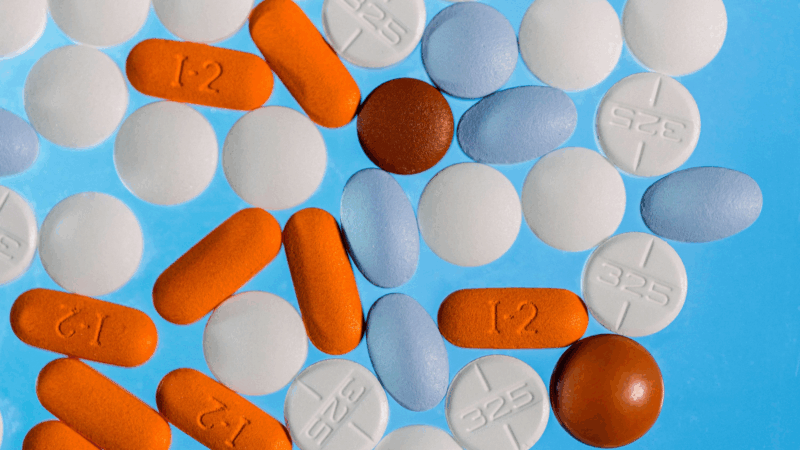You’re probably taking over-the-counter painkillers incorrectly
When hit with a headache or fever, people often reach for over-the-counter painkillers like acetaminophen or nonsteroidal anti-inflammatory drugs (NSAIDs) as their first line of defense.
Used correctly, these drugs can be safe and effective for pain relief. That means following the instructions on the label and the advice of a health care provider.
“But that’s not how we take these medications in real life,” says Trisha Pasricha, a physician and instructor at Harvard Medical School. Some people take too much pain medication too quickly, misdiagnose an ailment and take the wrong drug, or unknowingly take multiple pain relievers at the same time.
One study published in 2018, for example, found that 15% of over 1,300 survey participants exceeded daily NSAID dosages, and most participants didn’t recognize that all the products they were taking were NSAIDs.
These behaviors can lead to serious side effects, from bloating and nausea all the way up to heart attack and stroke, Pasricha says.
To prevent these risks, the health care professionals we spoke to for this story say it’s important to get to know the painkillers in your medicine cabinet. Here are 10 things they wish you knew about these drugs.
1. Acetaminophen is usually the better choice for fevers, says University of California San Francisco (UCSF) clinical pharmacist Candy Tsourounis. Commonly known as Tylenol, it’s thought to reduce fever and relieve minor aches and pains by raising your body’s pain threshold and regulating your body temperature. It’s also gentler on the body than NSAIDs are.
2. NSAIDs are generally considered more effective than acetaminophen for pain relief, Tsourounis says, especially for inflammatory pain like muscle aches. While acetaminophen is thought to work only on the central nervous system, NSAIDs such as aspirin, ibuprofen (like Advil or Motrin) or naproxen (like Aleve) work throughout the body to reduce inflammation, pain and fever.
3. Taking too much acetaminophen at one time or too many doses close together can cause liver damage, Tsourounis says. So stick to 3,000 milligrams of the drug at most per day, and don’t mix it with alcohol, which is also hard on the liver.
4. NSAIDs carry risks to the gut and the heart. Common side effects include stomach pain, heartburn and bloating. You can also experience more serious damage like ulcers, gastrointestinal bleeding or kidney damage if you take NSAIDs at too high a dose or even just for too long a time period, Pasricha says. And non-aspirin NSAIDs have the potential to raise your blood pressure. Every NSAID has a different max dose, so pay attention to your labels.
5. If you’re not sure which painkiller to use or how much to take, talk to a pharmacist, says Blamoh Twegbe, pharmacy manager at UCSF outpatient pharmacy. “Please utilize us. That’s what we’re here for!” They can help you make an informed decision by asking about your type of pain and chronic conditions and by checking any potential drug interactions.
6. There’s a limit to how much pain NSAIDs can treat, Pasricha says. If you take more than the recommended dosage or more than one type of NSAID at once — for example, combining Motrin and Aleve — you’re increasing your risk of side effects without getting any additional pain relief. If you feel your over-the-counter (OTC) drugs aren’t working, talk to a doctor or pharmacist instead of ignoring the warning label.

7. If you’re habitually reaching for the same OTC pain medication, talk to your health care provider. For example, if you’re taking naproxen every day of your period every month because of muscle cramps. Pasricha says that pain might signal a larger underlying health problem that could be better treated with prescription medication, lifestyle changes or both.
8. Beware of accidentally overmedicating with a combination OTC drugs. Acetaminophen and NSAIDs are often included in a lot of other sick-day remedies, like migraine medication, allergy pills or all-in-one cold and flu medicines, Twegbe says. So when you’re not feeling well, double-check your labels before assuming you need a dose of Tylenol on top of those cold-relief meds.

9. Alternate between NSAIDs and acetaminophen to manage major pain and reduce side effects. If you’re suffering from the flu or nursing a new injury and need strong and steady pain relief, switching between acetaminophen and an NSAID like ibuprofen every few hours can be a safe and effective way to help you cope until your symptoms subside, Twegbe says. Just make sure to follow recommended dosages and dosing times for each medication.
10. Think beyond pills. Because over-the-counter pain relievers are so readily available, people often forget that pills aren’t the only option when suffering from minor aches and pains, Pasricha says. Many NSAIDs and other analgesics are available in topical form, like creams or patches, and can offer similar relief without the potential side effects to your gut.
There are also nonmedication remedies, like heating pads to ease back pain or exercising in water for arthritis. Talk to your doctor about your alternatives, Pasricha says. “They might even control your pain more reliably than just taking medicine.”
The digital story was edited by Malaka Gharib. The visual editor is Beck Harlan. We’d love to hear from you. Leave us a voicemail at 202-216-9823, or email us at [email protected].
Listen to Life Kit on Apple Podcasts and Spotify, and sign up for our newsletter. Follow us on Instagram: @nprlifekit.
Alabama Power seeks to delay rate hike for new gas plant amid outcry
The state’s largest utility has proposed delaying the rate increase from its purchase of a $622 million natural gas plant until 2028.
Former U.S. Sen. Doug Jones announces run for Alabama governor
Jones announced his campaign Monday afternoon, hours after filing campaign paperwork with the Secretary of State's Office. His gubernatorial bid could set up a rematch with U.S. Sen. Tommy Tuberville, the Republican who defeated Jones in 2020 and is now running for governor.
Scorching Saturdays: The rising heat threat inside football stadiums
Excessive heat and more frequent medical incidents in Southern college football stadiums could be a warning sign for universities across the country.
The Gulf States Newsroom is hiring an Audio Editor
The Gulf States Newsroom is hiring an Audio Editor to join our award-winning team covering important regional stories across Mississippi, Alabama and Louisiana.
Judge orders new Alabama Senate map after ruling found racial gerrymandering
U.S. District Judge Anna Manasco, appointed by President Donald Trump during his first term, issued the ruling Monday putting a new court-selected map in place for the 2026 and 2030 elections.
Construction on Meta’s largest data center brings 600% crash spike, chaos to rural Louisiana
An investigation from the Gulf States Newsroom found that trucks contracted to work at the Meta facility are causing delays and dangerous roads in Holly Ridge.









